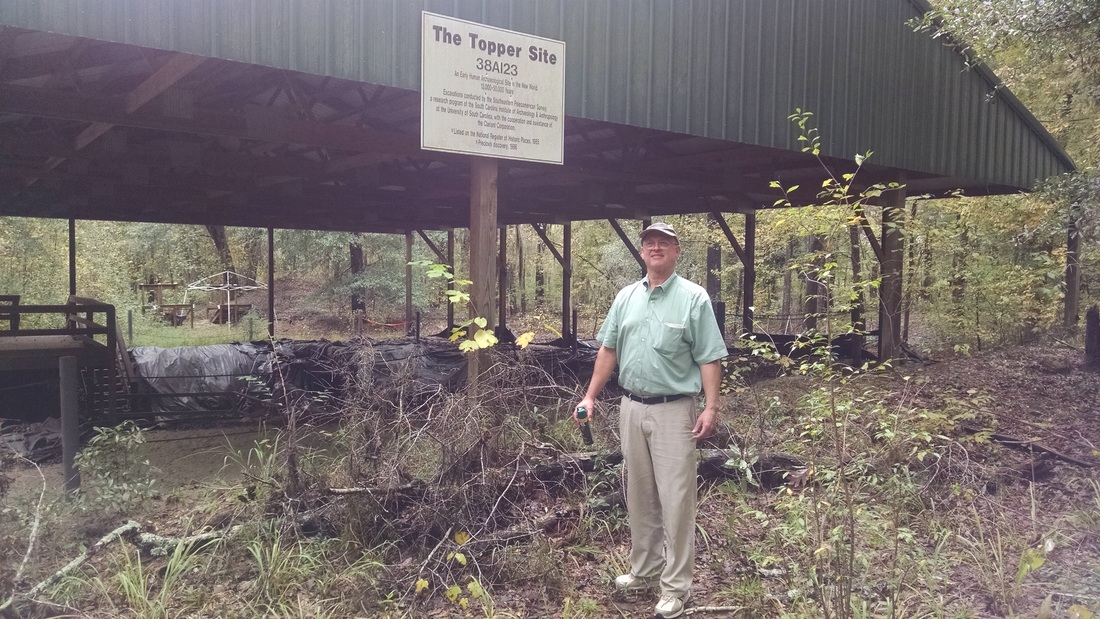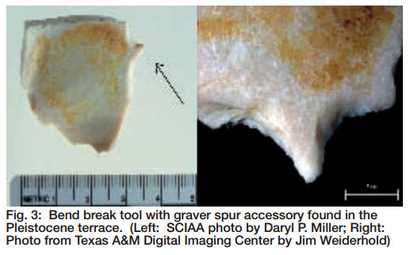 Al Goodyear in front of the deep excavation area at the Topper site. The mosquitoes were very happy to see us.
Al Goodyear in front of the deep excavation area at the Topper site. The mosquitoes were very happy to see us. The questions about the Topper pre-Clovis assemblage boil down to two main issues:
- Is the material cultural?
- Is it really that old?
Both of those issues are much simpler to raise then they are to answer.
Is It Cultural?
The "is it cultural" question is Question Number 1: if it's not cultural, then it doesn't really matter how old it is. Some archaeologists (such as Michael Collins in this Popular Archaeology article and this CNN story) have stated that the the pre-Clovis materials from Topper are the result of some natural process rather than the products of human behavior (i.e., they're "geofacts" rather than artifacts). If the Topper pre-Clovis "artifacts" are just a bunch of rocks, the rest of the story doesn't really matter.
Yesterday I looked at some of the material from Topper that is displayed at USC's Salkehatchie campus. I wasn't doing a systematic analysis, and I didn't actually handle the material (I was just looking through the glass like everybody else), so I'm not yet ready to offer a strong opinion of my own. I will say, however, that at least some of the objects displayed surely looked like good candidates for human-made stone tools and cores to me. There were several pieces that appeared to have fairly clear unifacial retouch, one flake with a very clear bulb of percussion, large "cores" that appeared to have multiple flake removals, etc.
 One of the pieces on display at the USC Salkehatchie campus: a graver from the pre-Clovis deposits at Topper. The image is from Goodyear's (2009) paper (link in the text).
One of the pieces on display at the USC Salkehatchie campus: a graver from the pre-Clovis deposits at Topper. The image is from Goodyear's (2009) paper (link in the text). "Evidence from this study supports King’s (2011) findings and demonstrates a human origin for the pre Clovis conchoidal flake assemblage at the site. However, this assemblage likely resulted from flake core and flake tool manufacture as opposed to biface manufacture and furthermore does not reflect bioturbation as an agent responsible for deposition. The assemblage is at minimum 14,000 BP and possibly much older. The bend break assemblage from the Lower Pleistocene Sands and Upper Pleistocene Terrace at Topper are also considered products of human agency based on the presence of specific technological attributes (compression rings, lips), retouch modification, and lack of differentially weathered scars."
I confess that I have only skimmed through Sain's dissertation at this point (it is 2400 pages). It's clear, however, that he's done a lot more than simply look at some pieces of stone and say "yup, looks like an artifact" or "nope, doesn't look like an artifact." He has looked more closely at the material than (I would guess) anyone else at this point. Thus his conclusions are an important data point suggesting that we shouldn't be so quick to dismiss the materials from Topper just because they are difficult to reconcile with the "knowns" of North American prehistory.
Is It Really That Old?
If the pre-Clovis materials from Topper are legitimate products of human behavior, can they really be 50,000 years old?
It looks to me like there is little question that the sediments (writ large) from which the Topper materials were excavated really do date to several tens of thousands of years ago. This (2009) paper by Michael Waters et al. discusses the geoarchaeology and dating of the Topper sediments, if you want to wade into the particulars.
Even if the general sediment stratigraphy is understood and well-dated, however, it is fair to ask if younger artifacts might have been introduced into older sediments through some sort of natural process - tree roots? animal tunnels? cracks in the earth? I wasn't present at any of the Topper excavations, so I can't really add anything about the possible role bioturbation might have played in moving artifacts around. Again, there is discussion in Sain's dissertation about whether some kind of bioturbation could explain how much younger (i.e., Clovis age) artifacts were introduced into such old sediment.
What If?
Healthy skepticism is an important part of doing good science. I'm as skeptical as the next person, and I think the extraordinary nature of the claims being made about Topper warrant significant scrutiny. What I (and many others, I think) are anticipating is the definitive publication by Goodyear that lays out the evidence and the argument in a succinct, clear way. That will let us evaluate the totality of the claim and find a path forward for future inquiry. The Topper site is still there, and new excavations could be conducted to target questions that develop from analysis of what has been done so far.
But take off the skeptic's hat for a minute and put on the "what if" hat: how cool would it be if there was an archaeologically-recognizable occupation of eastern North America pre-dating the Last Glacial Maximum? Where did those people come from? What were their societies like? What happened to them? Humor me for a minute here.
The time period between about 60,000 and 30,000 years ago (i.e., the time period that is claimed for some of the pre-Clovis materials from Topper) saw the movements of human groups into several previously-unoccupied parts of the world, including northern Asia, Japan, and Australia. What if an early wave of colonizers reached the New World? What if the 33,000 year-old remains from Monte Verde (Chile) were left behind by people in this first wave? What if the 48,000-32,000 year-old remains from Pedra Furada (Brazil) were also left by those early settlers? What if the stone tool technologies of these early settlers, like those of many Paleolithic groups in the Old World, were not based heavily on bifaces? What if a lack of formal bifaces in these early pre-Clovis technologies means that the lithic tools and debris left behind by these early settlers is "hiding in plain site," the nondescript assemblages of pre-Clovis flakes and unifacial tools blending in with the lithics left by much later peoples? What if that earliest occupation was ultimately unsuccessful, leaving behind no survivors and presenting no evidence for a historical connection between the technologies of its people and those of the people who followed?
That's a lot of "what ifs," but I think that's okay. "What ifs" are free.
If the pre-Clovis lithics from the Topper site were really produced by a very early human occupation of eastern North America, there is quite a story that remains to be told in this part of the world. And if that story is true, maybe Topper won't even be the site that can tell it the best. If there were people in the Southeast 50,000 years ago, it will ultimately be possible to find other examples of sites that they produced. Perhaps a systematic look at buried deposits predating the LGM will help produce some information (positive or negative) that can help us understand what Topper means. After visiting Topper and having a cursory look at some of the materials myself, I'm looking forward to watching the debate play out and seeing what happens next. Who knows -- I may get in on the action myself someday.


 RSS Feed
RSS Feed
